
Croxteth Hall is a country estate and Grade II* listed building in the West Derby suburb of Liverpool, England. It is the former country estate and ancestral home of the Molyneux family, the Earls of Sefton. After the death of the seventh and last Earl in 1972, the estate passed to Liverpool City Council, which now manages the remainder of the estate following the sale of approximately half of the grounds. The remaining grounds, Croxteth Park, were at one time a hunting chase of the Molyneux family and are now open to the public.

A mansion is a large dwelling house. The word itself derives through Old French from the Latin word mansio "dwelling", an abstract noun derived from the verb manere "to dwell". The English word manse originally defined a property large enough for the parish priest to maintain himself, but a mansion is usually no longer self-sustaining in this way. Manor comes from the same root—territorial holdings granted to a lord who would "remain" there. Following the fall of Rome, the practice of building unfortified villas ceased. Today, the oldest inhabited mansions around the world usually began their existence as fortified houses in the Middle Ages. As social conditions slowly changed and stabilized fortifications were able to be reduced, and over the centuries gave way to comfort. It became fashionable and possible for homes to be beautiful rather than grim and forbidding allowing for the development of the modern mansion.

West Derby is an area of Liverpool, in the county of Merseyside, England. It is located east of the city and is also a Liverpool City Council ward. At the 2011 Census, the population was 14,382.

Norris Green is a suburb and ward of Liverpool, England, in the east of the city. At the 2001 Census it had a population of 17,784, which had fallen to 15,047 at the 2011 Census.

Croxteth is a suburb of Liverpool, Merseyside, England, and a Liverpool City Council Ward. Although housing in the area is predominantly modern, the suburb has some notable history. At the 2011 census it had a population of 14,561.

Walton is an area of Liverpool, in Merseyside, England, north of Anfield and east of Bootle and Orrell Park. Historically in Lancashire, it is largely residential, with a diverse population.

Liverpool, West Derby is a constituency represented in the House of Commons of the UK Parliament since 2019 by Ian Byrne of the Labour Party. On 23 July 2024, Byrne was suspended from the Labour Party and had the whip withdrawn for six months, for voting to scrap the two child benefit cap. He now sits as an Independent.

Duxbury Woods is an area of woodland and parkland situated in Chorley, Lancashire, at the foot of the West Pennine Moors. The area originally existed as a township with the council meeting at the Yarrow Bridge pub; this was absorbed into Chorley Rural District in the early 20th century.
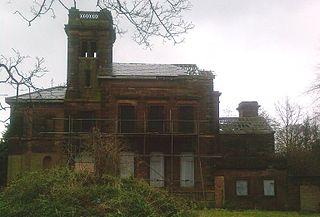
Gwalia in Liverpool, England is a Grade II listed building. It was built between 1851 and 1854 and was formerly known as Sandfield Tower.
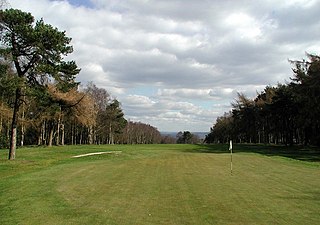
Bingley St. Ives, or St. Ives Estate is a 550-acre (2.2 km2) country park and former estate between Bingley and Harden in West Yorkshire, England now owned by Bradford Council. The park has Grade II listing in the English Heritage National Register of Historic Parks and Gardens of Special Interest. The park has been given Accredited Country Park status by Natural England.
Court Hey Park is a park in the Bowring Park suburb of Knowsley borough in Merseyside, England. It lies about 4+1⁄2 miles (7 km) east of Liverpool city centre.
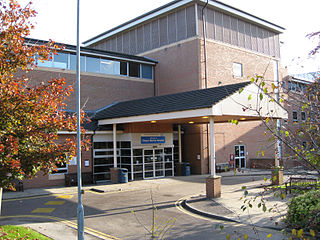
Chapel Allerton Hospital is located in the area of Chapel Allerton, Leeds, West Yorkshire, England and is operated by the Leeds Teaching Hospitals NHS Trust. The main entrance is on Chapeltown Road, with vehicle exits onto Harehills Lane and Newton Road.

Allerton Towers Park is a public park in Allerton, Liverpool, in England.
Liverpool is a city and port in Merseyside, England, which contains many listed buildings. A listed building is a structure designated by English Heritage of being of architectural and/or of historical importance and, as such, is included in the National Heritage List for England. There are three grades of listing, according to the degree of importance of the structure. Grade I includes those buildings that are of "exceptional interest, sometimes considered to be internationally important"; the buildings in Grade II* are "particularly important buildings of more than special interest"; and those in Grade II are "nationally important and of special interest". Very few buildings are included in Grade I — only 2.5% of the total. Grade II* buildings represent 5.5% of the total, while the great majority, 92%, are included in Grade II.

Grainsby is a hamlet and civil parish in the East Lindsey district of Lincolnshire, England. It is situated 5 miles (8 km) south from Grimsby, and just to the west from the A16 road. The nearest village is North Thoresby, 1 mile (1.6 km) to the south-east.

Green Buren Adair was a prominent Atlanta cotton merchant who conducted business in Atlanta from the Civil War until the turn of the 20th century. He was a cousin of George Washington Adair, another prominent real estate mogul in Atlanta.
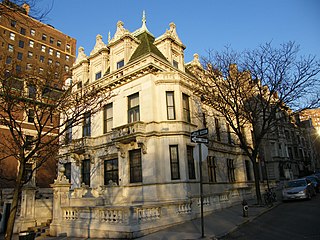
The Schinasi House is a 12,000-square-foot (1,100 m2), 35-room marble mansion located at 351 Riverside Drive on the Upper West Side of Manhattan in New York City. It was built in 1907 for Sephardic Jewish tobacco baron Morris Schinasi. Completed in 1909 at the northeast corner of West 107th Street and Riverside Drive, the three-story, 12,000 square foot mansion was designed in neo-French-Renaissance style by William Tuthill.
John Pemberton Heywood (1803–1877) was a banker from Liverpool, England, who was High Sheriff of Lancashire in 1855.

Rosshall is an area in the south-west of Glasgow, Scotland, within the Cardonald ward of Glasgow City Council. It has a fairly isolated location, with the White Cart Water forming a border to the south and east, the Paisley Canal Line railway to the north, and open fields to the west that form a short green belt between Glasgow and the large town of Paisley – the nearest building 500 yards (460 m) to the west, Rosshall Mains Farm, falls under Paisley administration rather than Glasgow.
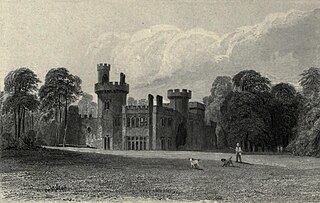
Childwall Hall was a 19th-century English country house located in Childwall, Liverpool, England. Built on the site of a previous mansion of the same name the Gothic Revival building was the seat of parliamentarian Bamber Gascoyne, a noted opponent of the abolition of slavery. The main building was demolished in 1949 and the current site is now occupied by a television production company Lime Pictures. A lodge building and a few ruins of the same style are all that remain of the hall.



















